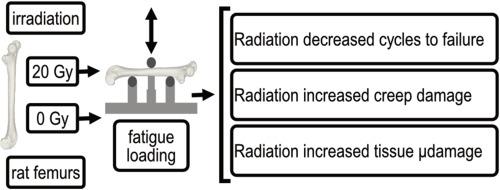治疗性辐射会直接改变骨疲劳强度和微损伤累积。
IF 3.3
2区 医学
Q2 ENGINEERING, BIOMEDICAL
Journal of the Mechanical Behavior of Biomedical Materials
Pub Date : 2024-10-02
DOI:10.1016/j.jmbbm.2024.106766
引用次数: 0
摘要
放疗(RTx)是一种重要而有效的肿瘤治疗方法,但放疗后骨质脆性骨折却是一个具有挑战性的临床问题。接受过 RTx 治疗的癌症幸存者发生这种晚期复杂脆性骨折的风险各不相同。尽管疲劳负荷很可能是导致创伤性骨折的机制之一,但有关 RTx 对骨疲劳特性影响的数据却很少。在这项研究中,用治疗剂量的 x 射线(20 Gy)对成年雄性大鼠的股骨进行体外照射,然后使用三点弯曲装置进行疲劳试验。将股骨置于室温下的等渗槽中,在力控制下以 3 Hz 的频率加载至规定的初始应变水平范围(基于梁理论方程,在出现任何疲劳损伤之前)。本研究的目的是确定评估 RTx 引起的以下变化的可行性:1)股骨疲劳强度;2)结构微损伤(蠕变和刚度);3)组织损伤(弥漫损伤和/或线性微裂纹)。中骺形态和组织矿物质密度在 RTx 组和 Sham 组之间没有差异(p ≥ 0.35)。与 Sham 组相比,随着外加表观应变的增加,RTx 组股骨的破坏循环次数减少(处理 x εapp,p = 0.041)。与 Sham 股骨相比,RTx 股骨的第二阶段(稳态)蠕变率更高(p = 0.0462)。对于达到 50 万次循环的股骨,RTx 组比 Sham 组的弥漫性损伤面积更大(p = 0.015)。这项研究提供的证据表明,治疗剂量的辐射可直接降低骨疲劳特性。这种疲劳特性的丧失与结构性疲劳损伤和弥漫性微损伤的增加有关,而形态学或组织矿物质密度并没有发生改变,这表明骨质量有所下降。本文章由计算机程序翻译,如有差异,请以英文原文为准。

Therapeutic radiation directly alters bone fatigue strength and microdamage accumulation
Radiotherapy (RTx) is an essential and efficacious oncologic treatment, however, post-RTx bone fragility fractures present a challenging clinical problem. Cancer survivors treated with RTx are at variable risk for these late-onset, complex fragility fractures. Little data exists regarding the effects of RTx on bone fatigue properties despite the likelihood of fatigue loading as a mechanism leading up to atraumatic fracture. In this study, femurs collected from adult male rats were irradiated ex vivo with a therapeutic dose of x-irradiation (20 Gy), and then fatigued using a three-point bend setup. Femurs positioned in an isotonic bath at room temperature were loaded to a range of prescribed initial strain levels (based on beam theory equations, prior to any fatigue damage) at 3 Hz in force control. The goals of this study were to determine the feasibility of assessing RTx-induced alterations in 1) femur fatigue strength, 2) structural microdamage (creep and stiffness), and 3) tissue damage (diffuse damage and/or linear microcracking). Mid-diaphyseal morphology and tissue mineral density were not different between the RTx and Sham groups (p ≥ 0.35). With increasing applied apparent strain, the number of cycles to failure was reduced for the RTx femurs when compared to the Sham femurs (treatment x εapp, p = 0.041). RTx femurs had a greater phase II (steady state) creep rate (p = 0.0462) compared to Sham femurs. For femurs that reached 500k cycles, the RTx group had greater diffuse damage area (p = 0.015) than the Sham. This study provides evidence that radiation at therapeutic doses can directly diminish bone fatigue properties. This loss of fatigue properties is associated with increased structural fatigue damage and diffuse microdamage, without alterations in morphology or tissue mineral density, indicating a reduction in bone quality.
求助全文
通过发布文献求助,成功后即可免费获取论文全文。
去求助
来源期刊

Journal of the Mechanical Behavior of Biomedical Materials
工程技术-材料科学:生物材料
CiteScore
7.20
自引率
7.70%
发文量
505
审稿时长
46 days
期刊介绍:
The Journal of the Mechanical Behavior of Biomedical Materials is concerned with the mechanical deformation, damage and failure under applied forces, of biological material (at the tissue, cellular and molecular levels) and of biomaterials, i.e. those materials which are designed to mimic or replace biological materials.
The primary focus of the journal is the synthesis of materials science, biology, and medical and dental science. Reports of fundamental scientific investigations are welcome, as are articles concerned with the practical application of materials in medical devices. Both experimental and theoretical work is of interest; theoretical papers will normally include comparison of predictions with experimental data, though we recognize that this may not always be appropriate. The journal also publishes technical notes concerned with emerging experimental or theoretical techniques, letters to the editor and, by invitation, review articles and papers describing existing techniques for the benefit of an interdisciplinary readership.
 求助内容:
求助内容: 应助结果提醒方式:
应助结果提醒方式:


